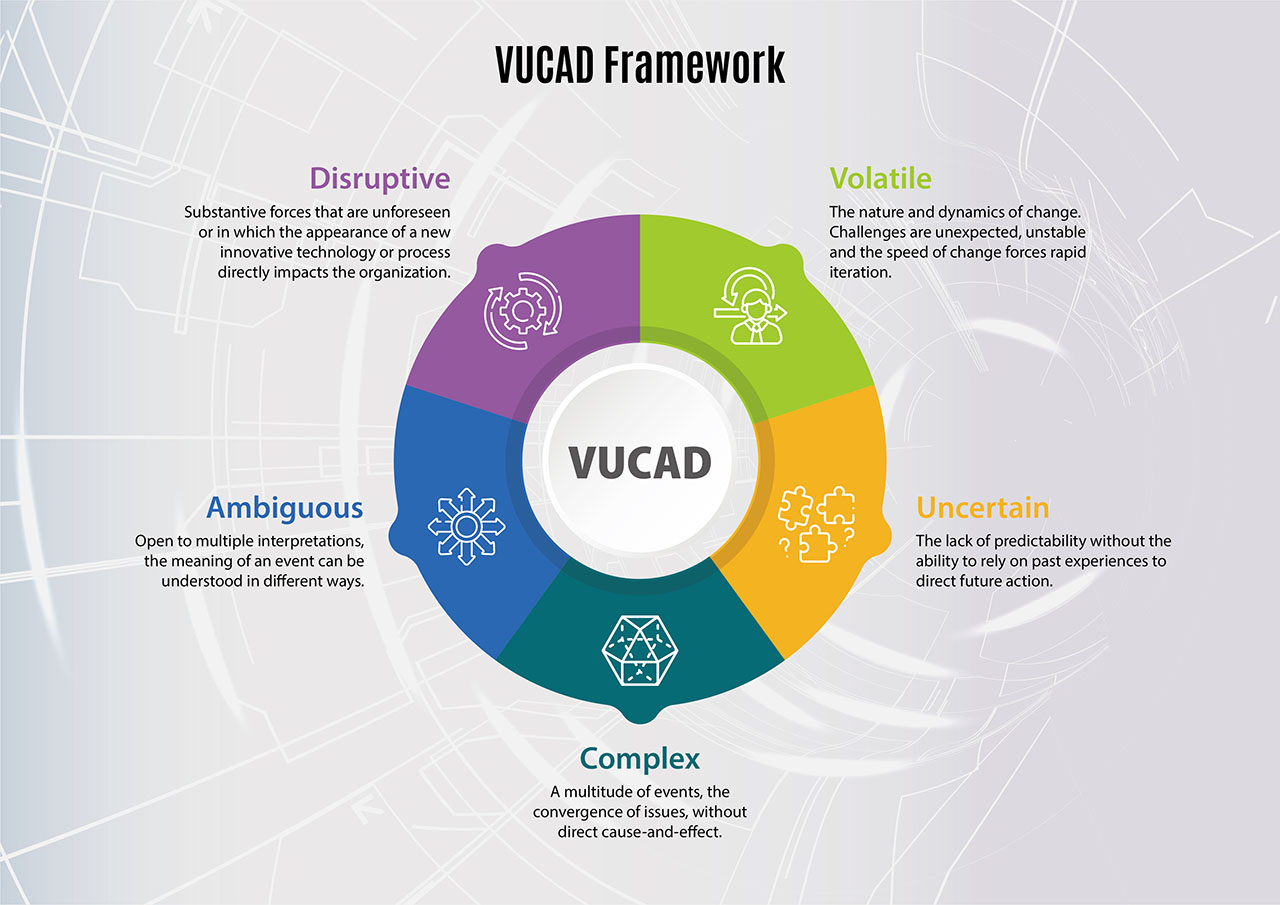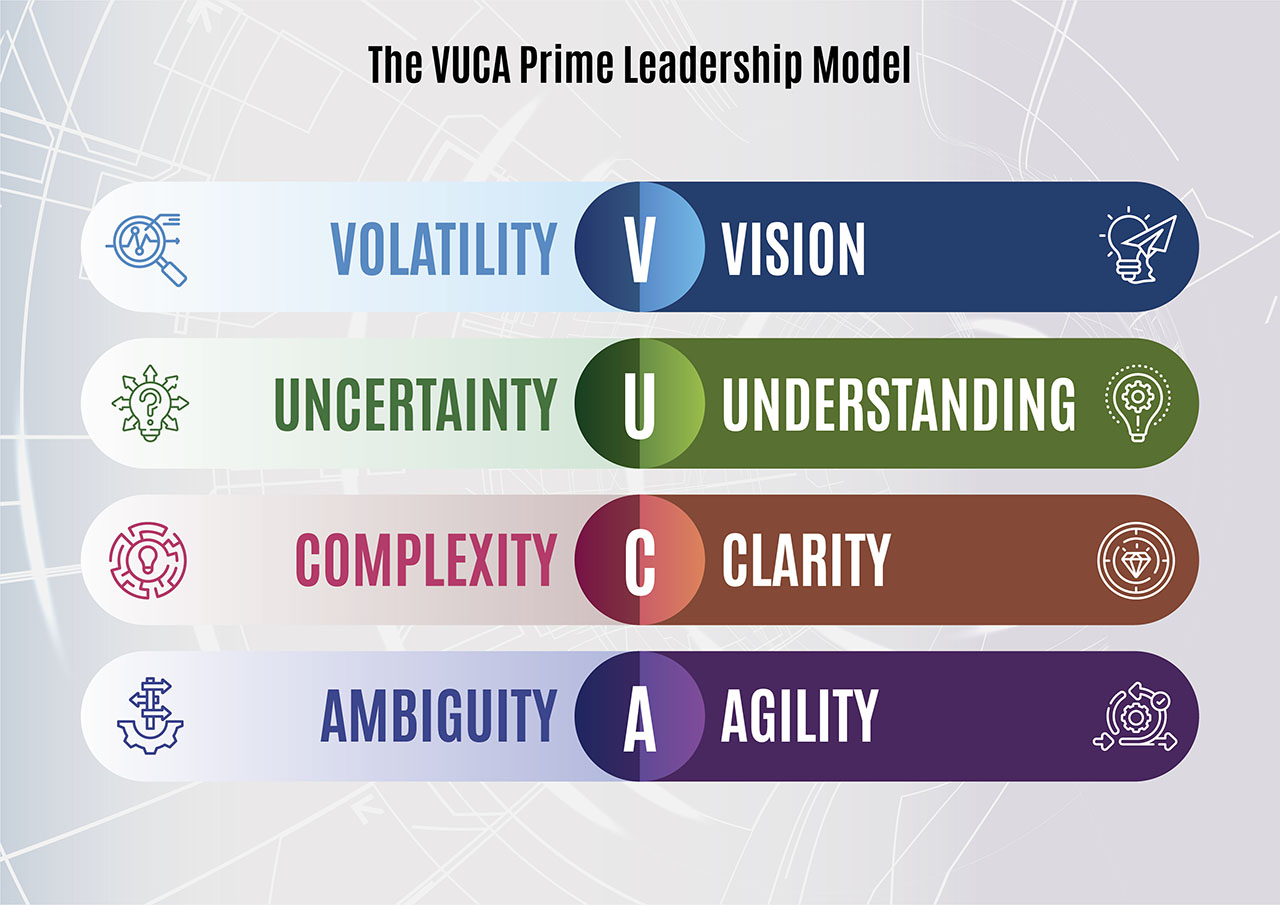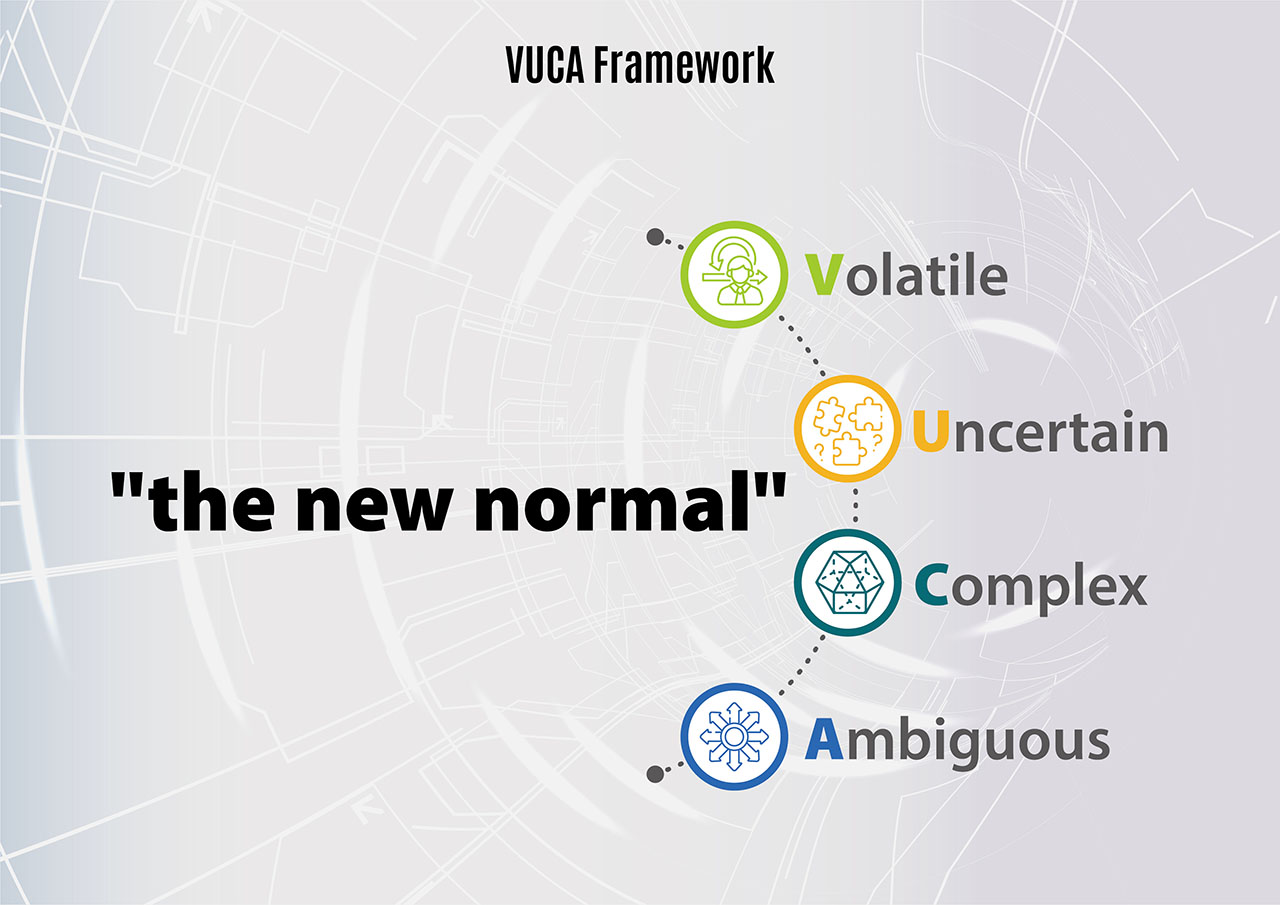The VUCA Framework
In the post-pandemic highly disruptive and digital-driven world, organizations continue to be impacted by a multitude of changes, influencing the way they operate. With increasing volatility in the markets, ever-changing customer needs, and continuous technology-led disruptions to business models, it is an organization’s agility and resilience that can help it weather the storm of changes that hit it every day.
On the other hand, the complexity and disruptions in the business environment today continuously decrease the visibility of businesses beyond a quarter, impeding organizations’ ability to build long-term plans and requiring them to reinvent continually. Leaders would need to understand the following implications of the characteristics of VUCA (Volatile, Uncertain, Complex, Ambiguous) for their organization, and its relevance to today’s workplace is clear because these conditions are highly descriptive of the environment in which business is conducted every day.(Bawany, 2020)
The four elements of VUCA describe the “fog of war”— the chaotic conditions that are encountered on a modern battlefield. Leaders need to be comfortable with uncertainty, have the self-awareness and self-confidence to make speedy but thoughtful decisions in ambiguity and communicate consistently, clearly and openly, even when there is nothing to communicate.
Figure 1: The four elements of the VUCA business environment
The four elements of VUCA (see Figure 1) describe the “fog of war”— the chaotic conditions that are encountered on a modern battlefield. Leaders need to be comfortable with uncertainty, have the self-awareness and self-confidence to make speedy but thoughtful decisions in ambiguity and communicate consistently, clearly, and openly, even when there is nothing to communicate.
Leading in a post-pandemic VUCA world not only provides a challenging environment for leaders to operate and for executive development programs to have an impact but also offers a much-needed range of new competencies. The new reality is that organizations are beginning to acknowledge that new and different capabilities are needed to succeed in this era of the “new normal” or the “next normal” workplace.
The concept of VUCA was originally developed by the U.S. military in the late 1980s to describe the post-Cold War world. It was later widely adopted in the business world to describe challenging, rapidly changing environments. Over time, researchers and organizations have expanded the concept to VUCAD, where the “D” stands for Disruption (See Figure 1) (Bawany 2025). Events like the COVID-19 pandemic, climate change, and geopolitical conflicts have caused unpredictable and transformative disruptions to societies and economies. In the digital age, change is not only rapid but also exponential. Traditional volatility doesn’t fully capture the transformative nature of emerging technologies, global crises, and paradigm shifts. Technologies like AI, blockchain, and automation aren’t just complicating existing systems — they’re disrupting entire industries, creating new models while rendering others obsolete.
The shift to VUCAD means that leaders must go beyond simply managing change — they need to anticipate disruptions, foster resilience, and promote agility and innovation. Traditional risk management isn’t enough; organizations must develop the capacity to pivot and reinvent themselves. For leaders and organizations, managing disruption has become a core competency, not just a subset of volatility or complexity.
The VUCAD framework (See Figure 2) captures the challenging realities of today’s business environment, where rapid changes and interconnected dynamics significantly impact organizations and their leaders (Bawany 2025).

Figure 2: The “V.U.C.A.D.” Framework

1. Volatile
- Definition: Rapid and unpredictable changes that disrupt stability and continuity.
- Examples: Market fluctuations, sudden technological breakthroughs, or shifts in consumer behavior.
- Implications: Leaders must remain agile, adaptable, and ready to respond swiftly to change.

2. Uncertain
- Definition: Lack of predictability in events and outcomes due to insufficient or unclear information.
- Examples: Geopolitical instability, economic uncertainty, or evolving industry regulations.
- Implications: Leaders must develop resilience and decision-making skills to navigate ambiguity and make informed choices.

3. Complex
- Definition: The multifaceted and interconnected nature of challenges, with many influencing factors.
- Examples: Global supply chain intricacies, diverse workforce dynamics, and interdependent market systems.
- Implications: Leaders need systems thinking and the ability to manage diverse, interconnected variables effectively.

4. Ambiguous
- Definition: Situations with unclear meanings or outcomes, making interpretation and strategy formulation difficult.
- Examples: Emerging markets with undefined rules, or disruptive technologies with uncertain impacts.
- Implications: Leaders must cultivate creativity, innovative thinking, and the capacity to act decisively in unclear scenarios.

5. Disruptive
- Definition: The constant presence of innovation and disruption that challenges existing norms and practices.
- Examples: Digital transformation, industry convergence, and new competitors from unexpected sectors.
- Implications: Leaders must embrace disruption as an opportunity for reinvention and foster a culture of continuous innovation.
The VUCA Prime Model
The four elements of VUCA identify the internal and external conditions affecting organizations today. The VUCA Prime model (see Figure 3) was developed by Robert Johansen, a distinguished fellow at the Institute for the Future and the author of Leaders Make the Future: Ten New Leadership Skills for an Uncertain World. (Johansen 2012). Johansen flips the VUCA model and focuses on the characteristics and skills business leaders must develop to counter the effects of a VUCA environment. Johansen proposes that the best VUCA-driven disruptive leaders have a vision, understanding, clarity, and agility.

Figure 3: The VUCA Prime model
In the VUCA Prime model, Volatility can be countered with vision because vision is even more vital in turbulent times. Leaders with a clear vision of where they want their organizations to be can better weather disruptive environmental changes such as economic downturns or new competition. They can make business decisions to counter the turbulence while keeping the organization’s vision in mind (Bawany 2020).
Uncertainty can be countered with understanding and the ability to stop, look, and listen. To be successful in a VUCA environment, leaders must learn to look and listen beyond their functional areas to make sense of the volatility and to lead with vision. Leaders would be required to communicate with all levels of employees in their organization and to develop and demonstrate teamwork and collaboration skills leveraging the SCORE™ high-performance team framework (Bawany 2019, 2020).
Complexity can be countered with clarity, which is the process of trying to make sense of chaos. In a VUCA world, chaos comes swiftly and hard. Leaders who can quickly tune into all of the specifics associated with the chaos can make better, more informed business decisions.
Finally, Ambiguity can be countered with agility, the ability to communicate across the organization and to move quickly to apply appropriate solutions to the pressing challenges on hand. Vision, understanding, clarity, and agility are not mutually exclusive in the VUCA Prime. Instead, they are intertwined elements that help managers become more influential VUCA leaders.
The VUCA Prime model can be seen as the continuum of skills leaders can develop to help make sense of leading in a VUCA world. HR and talent management professionals can use the VUCA Prime as a “skills and abilities” blueprint when creating leadership development plans (Bawany 2020).
VUCA leaders must have the foresight to see where they are going but must also remain flexible about how they get there. They must demonstrate a high level of self-awareness of their strengths and weaknesses as leaders, cognitive readiness and critical thinking skills, and mental and learning agility to learn fast because change is constant. Resilience, adaptability, opennessto change, working collaboratively, and being excellent communicators are essential traits to thrive in a complex VUCA environment.
These skills and abilities are a far cry from the more function-specific skills and abilities leaders needed in the past to succeed. HR and talent management professionals must refocus their leadership development efforts to hone these more strategic, complex critical-thinking skills.
Why VUCAD Matters for Leadership Development
The VUCAD environment demands leaders who can:
- Anticipate and Adapt: Recognize trends and pivot strategies as needed.
- Think Critically and Strategically: Approach challenges with long-term and holistic perspectives.
- Inspire and Empower: Motivate teams to remain engaged, innovative, and productive amid chaos.
- Embrace Change as Growth: Treat disruption as a chance to innovate and improve organizational resilience.
- Communicate Effectively: Foster clarity and alignment despite ambiguity and complexity.
Leadership Strategies for VUCAD Environments
- Agility: Build nimble teams and processes that adapt to rapid changes.
- Resilience: Develop mental and organizational fortitude to thrive in adversity.
- Collaboration: Leverage diverse perspectives to solve multifaceted challenges.
- Continuous Learning: Stay updated on trends and technologies to stay ahead of disruption.
- Empathy and Emotional Intelligence: Lead with understanding to navigate uncertainty and ambiguity effectively.
The VUCAD Framework serves as a reminder of the challenges that define modern leadership, emphasizing the need for flexibility, foresight, and innovation in navigating the ever-changing landscape of business and society.
Reference:
- Bawany, S. 2025. The Making of a C.R.I.S.I.S. Leader. New York, NY: Business Express Press (BEP) Inc. LLC.
- Bawany, S. 2023. Leadership in Disruptive Times: Negotiating the New Balance. New York, NY: Business Express Press (BEP) Inc. LLC.
- Bawany, S. 2020. Leadership in Disruptive Times. New York, NY: Business Express Press (BEP) Inc. LLC.
- Bawany, S. 2019. Transforming the Next Generation of Leaders: Developing Future Leaders for a Disruptive, Digital-Driven Era of the Fourth Industrial Revolution (Industry 4.0).New York, NY: Business Express Press (BEP) Inc. LLC.
- Bawany, S. 2014. “Building High-Performance Organizations with Results-based Leadership (RBL) Framework.” Leadership Excellence Essentials 31, no. 11, pp. 46–47.
- Bawany, S. 2016. “NextGen Leaders for a VUCA World: Transforming Future Leaders for Success” Leadership Excellence Essentials HR.com August 2016 Issue.
- Bawany, S. 2016. “How to: Develop the toolbox of skills that business leaders require.” Human Resources Online, July 5, 2018 Issue

